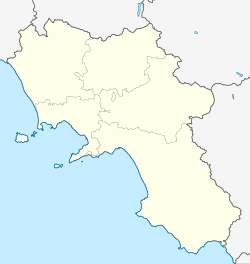
Giugliano in Campania, also known simply as Giugliano, is a city and comune (municipality) in the Metropolitan City of Naples, Campania, Italy. A suburb of Naples, as of 2017, it had some 124,000 inhabitants, making it the most populated Italian city that is not a provincial capital.
F.C. Neapolis was an Italian association football club located in Mugnano di Napoli, Campania. It last played in Serie D.
Carinola is a comune (municipality) in the Province of Caserta in the Italian region Campania, located c. 45 kilometres (28 mi) northwest of Naples, c. 30 kilometres (19 mi) northwest of Caserta, and c. 187 kilometres (116 mi) southeast of Rome.
Parete is a comune (municipality) in the Province of Caserta in the Italian region Campania, located about 15 kilometres (9 mi) northwest of Naples and about 20 kilometres (12 mi) southwest of Caserta. As of 31 December 2004, it had a population of 10,597 and an area of 5.7 square kilometres (2.2 sq mi).
Pignataro Maggiore is a comune (municipality) in the Province of Caserta in the Italian region Campania, located about 40 kilometres (25 mi) north of Naples and about 20 kilometres (12 mi) northwest of Caserta.
Rocchetta e Croce is a comune (municipality) in the Province of Caserta in the Italian region Campania, located about 45 kilometres (28 mi) north of Naples and about 25 kilometres (16 mi) northwest of Caserta.
Sparanise is a comune (municipality) in the Province of Caserta in the Italian region Campania, located about 40 kilometres (25 mi) northwest of Naples and about 25 kilometres (16 mi) northwest of Caserta. Its surrounding communities are the villages of Francolise, Calvi Risorta, and Pignataro Maggiore.
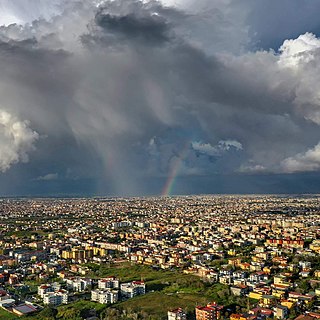
Marano di Napoli is a comune (municipality) in the Metropolitan City of Naples in the Italian region of Campania, located about 9 kilometres northwest of Naples. Partly located on the Camaldoli hill, it is one of the most populous municipalities in the metropolitan city.
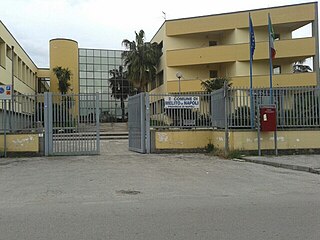
Melito di Napoli is a comune (municipality) in the Metropolitan City of Naples in the Italian region of Campania, located about 9 kilometres (5.6 mi) north of Naples.

Mugnano di Napoli is a comune (municipality) in the Metropolitan City of Naples in the Italian region of Campania, about 10 km northwest of Naples.
Qualiano is a comune (municipality) in the Metropolitan City of Naples in the Italian region Campania, located about 13 kilometres (8.1 mi) northwest of Naples.

Quarto is a comune (municipality) in the Metropolitan City of Naples in the Italian region Campania, located about 11 km northwest of Naples.
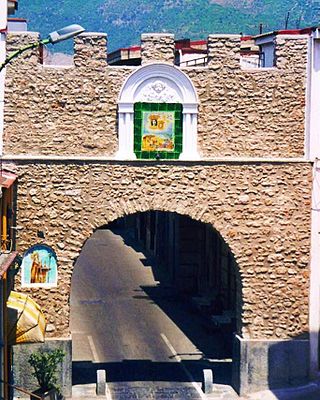
Striano is an Italian municipality of 8 764 inhabitants in the Metropolitan City of Naples in Campania, located in the Sarno Valley.
Villaricca, known until 17 May 1871 as Panicocoli, is a comune (municipality) in the Metropolitan City of Naples in the Italian region of Campania, located about 10 km northwest of Naples.
Internapoli Football Club was an Italian association football club based in the Vomero area of Naples, Campania. Founded in 1909 as S.C. Vomero, the club has been re-launched several times, first in 1935, under the auspices of Cral Cirio, and later, in 1964, under Internapoli dominion.
The Di Lauro clan is an Italian crime clan, part of the Camorra in Naples. The clan operates in the neighbourhoods of Secondigliano, Scampìa, Miano, Marianella, Piscinola, and in the adjacent municipalities of Casavatore, Melito, Arzano, Villaricca and Mugnano. At its peak, between the mid-1990s and the early 2000s, the organization was earning more than €500,000 a day from the sale of drugs alone, making Secondigliano the largest open-air drug market in Europe. The founder of the clan is Paolo Di Lauro, from Via Cupa dell'Arco, in Secondigliano.

The Eighth Municipality is one of the ten boroughs in which the Italian city of Naples is divided.
Cesina is a toponym of Langobard origin that is used in southern Italy, especially in Campania. It derives from the Latin word caesi and the Latin verb caedere, to which the Langobard suffix -na is added.
The Polverino clan is a Neapolitan Camorra clan operating in the town of Marano di Napoli. The clan is present also in Villaricca, Quarto, Pozzuoli, Qualiano and in the district Camaldoli of Naples. Outside Italy, the clan has a strong presence in Spain, in particular in Barcelona, Málaga and Alicante. According to the investigations, the Polverinos are considered the successors of the Nuvoletta clan.
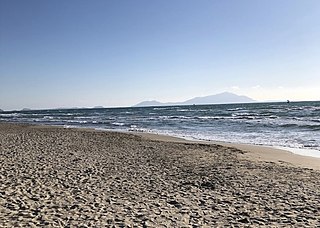
Agro giuglianese is an area of the Metropolitan City of Naples, Campania, Italy.


